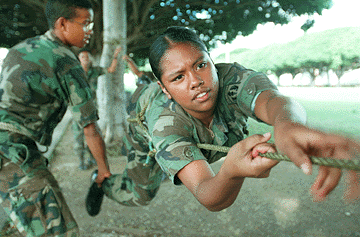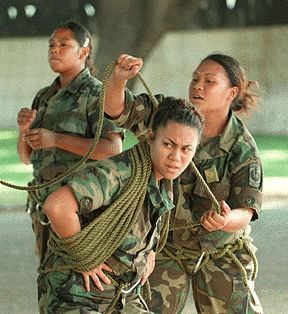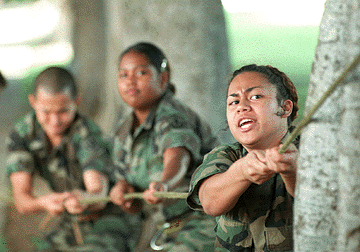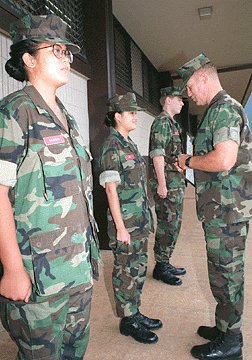
By Dennis Oda, Star-Bulletin
Charmane Ginoza pulls herself along a rope with
the help of Joshua Dixon.

Cadet Maj. Cana Gomes, battalion commander of McKinley High School's Army JROTC, likes the program because of its emphasis on leadership training.
"It makes me more responsible and makes me stay on top of things and not stall," said the McKinley senior, who hopes to pursue a career in nursing.
Castle High School JROTC Marine Corps cadet Pvt. Andy Schlipf believes the program teaches students "respect for others. It also teaches us to be disciplined."
Military officials see the upsurge as a change in student attitudes, values and the sense of stability the program brings.

"They get a good feeling after participating in a parade or a community service."
Since 1992, the number of Junior ROTC programs on the mainland has risen by more than 60 percent, from 1,481 to about 2,400.
The climb also has been steady in Hawaii, with 3,587 students now in uniform, an increase of nearly 13 percent over a year ago. Last year, Castle High School in Windward Oahu and Waimea High School on Kauai joined the program, with dramatic results.
"We're so proud of our program," said Castle High Principal Barbara Teruya. "In just a year's time, we've won more than 11 awards, making us one of the most decorated units."
Retired Marine Corps Maj. Gary Hall, senior instructor at Castle, said the program began with 64 cadets last year and climbed to 94 in September. "Our goal is to have over 100 kids at the end of three years. I think we will get that easily."

"When ROTC was mandatory here," he said, "we had more than 1,200 students. That was until the early 1960s."
Kamehameha School established the first JROTC unit in Hawaii in 1916, followed by Punahou School in 1918. McKinley was the first public school unit in 1921 followed by Roosevelt in 1938.
Kamehameha, one of the charter schools under the 1916 National Defense Act, is the only institution with a mandatory two-year program for males. The other programs in the state are coed.
Tom said there are now 2,700 public school students enrolled at 24 schools. An additional 860 private school students are in programs at Damien, Punahou, St. Louis, Kamehameha and St. Joseph High School on the Big Island. All students get one credit for a year's participation.
The 29 high schools participating in JROTC make Hawaii proportionately one of the highest JROTC concentrations in the United States.

In addition to classroom instruction on military history and science and current affairs, the students can participate on the rifle team, which is a letter sport in the public high schools, drill team, adventure training team, color guard, honor guard, summer camps and field trips. And they can attend military balls.
Retired Marine Corps Sgt. Maj. John Ah Chick said the program at Castle High stresses community service as "part of the curriculum, and each quarter the cadets participate in a project." He said it strengthens self-esteem and develops leadership potential.
"It's our way of giving back to the community," said Ah Chick, a 23-year Marine Corps veteran.